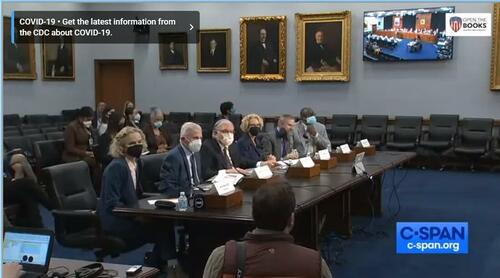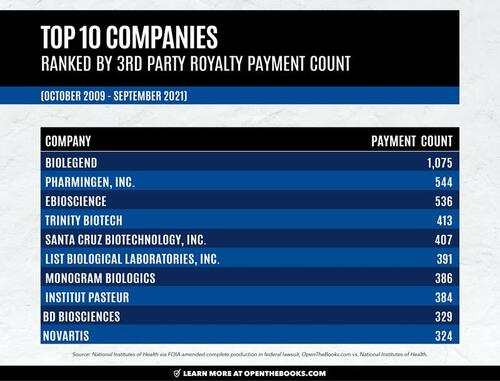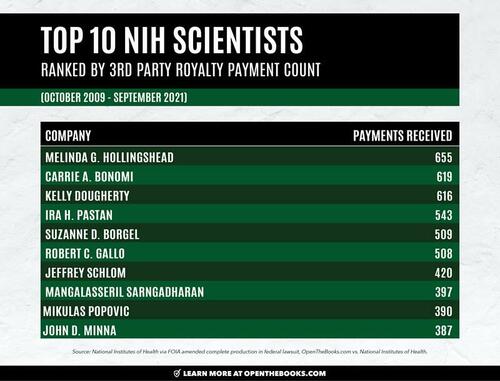Fauci Defended NIH Culture Of Secrecy: The $325M Third-Party Royalty Complex... Now We Know The Details
By Adam Andrzejewski, author of OpenTheBooks substack,
Newly released NIH documents show conclusively that statements made during congressional hearings to U.S. Sen. Rand Paul (R-KY) and Rep. John Moolenaar (R-MI) by NIH leaders Anthony Fauci and Lawrence Tabak were misleading, if not outright false, regarding third-party royalties paid before, during, and after the pandemic.

Tabak, acting director of the National Institutes of Health, and Fauci, then-director of the National Institutes of Allergies and Infectious Diseases, both claimed before Congress that they could not release the names of the companies paying NIH third party royalties.
Last week, however, our OpenTheBooks lawsuit based on our Freedom of Information Act request caused NIH to release new documents.
The newly released documents reveal – for the first time – the names of companies that paid NIH scientists $325 million in third party royalties from 56,000 transactions between September 2009 and October 2020.
Our OpenTheBooks oversight reporting — which led to three congressional hearings during 2022 regarding NIH’s secret third party royalty payments — is available here for review.
Here are some key findings from the new disclosures:
-
In U.S. Senate hearings during 2022, Dr. Anthony Fauci refused to disclose the companies who licensed his “inventions” and paid his third-party royalties. Finally, now, we know the companies paying him. They are listed below.
-
Chinese government-owned pharmaceutical companies, controlled by the Chinese Communist Party (CCP), paid the National Institutes of Health (NIH) third-party royalties to license technologies developed on the U.S. taxpayer dime. One such company neighbors the Wuhan Institute of Virology, collaborates with the lab, and even paid a royalty to Douglas Lowy, a multiple term acting director at the National Cancer Institute, a sub-institute of NIH.
-
Russian animal vaccine maker – which was allegedly a front for a Soviet bio-weapons lab – licensed inventions and paid royalties to NIH for tech developed with taxpayer dollars.
-
Purdue Pharma – the makers of the highly addictive and frequently abused OxyContin (oxycodone) – licensed tech developed with public funds and paid royalties to NIH – even after the company pleaded guilty to federal crimes relating to opioids.
-
Long-serving former NIH director, Francis Collins, received third party royalties on his inventions from four companies that themselves received nearly $50 million in federal contracts and grants since 2008.
During the pandemic, the American people started to worry that Big Government was too close to Big Pharma. Now, because of our oversight investigation at OpenTheBooks.com, we know just how close they are: NIH spends billions on the industry and now we know the industry sends millions back to NIH and its scientists.
Last year, the National Institutes of Health – Fauci’s former employer – doled out more than $30 billion in government grants to roughly 56,000 recipients. That taxpayer largess buys plenty of friends and enormous influence across the entire U.S. healthcare complex – the scientific, research, drug, therapeutic, and healthcare industries.
In turn, $325 million in royalty payments flowed back in the other direction from private companies, research outfits, non-profits, and academia to NIH and its scientists.
These payments from third-party payers enriched the agency, its leadership, and 2,400 individual NIH scientists. It took our Freedom of Information Act request – ignored by NIH in September 2021 – and our federal lawsuit filed in November 2021 to finally force production of these payment records. The public interest law firm, Judicial Watch, represents us.
Supported by Tabak and Fauci’s false testimony to Congress, NIH initially redacted the name of the payor (company), the amount paid to the individual scientist (think Fauci) and what was invented by the taxpayer-paid scientist in the government lab (license/patent number) from their initial 3,000 pages of court-ordered production during 2022.
With so much information completely blacked out, the pages NIH produced were virtually useless for the purpose of scrutinizing these records for potential conflicts of interest or public health risks.
Their production defied the court and the public’s right to know. For a gaggle of doctors, they were treating the sunlight of transparency like an unknown pathogen.
Significant Transparency Victory Achieved
Until last week. That’s when NIH provided new production disclosing a partial two of the three formerly redacted items on all royalties paid since 2009: 1. The name of the third-party payor; and 2. The license number on the NIH invention.
NIH still refuses to disclose the dollar amount paid to the individual scientist and will not disclose patent numbers either. We will exhaustively litigate what we consider to be NIH’s smoking cover-up gun of defiance toward informing the taxpayers whose agency it is.
Background: What is a third-party royalty? When a government scientist invents something, it can be licensed to the private sector for enhancement, distribution, and profit-making. Under the law, the private entity pays royalties back to NIH – enriching the agency, its leaders, and its scientists.
Watch the U.S. Senate hearing where Fauci obfuscated and defended secrecy at the expense of our right to know while being questioned by Sen. Rand Paul (R-KY):
Fauci, Collins, Et Al – Who Paid Them?
We now know “Who” paid royalties to agency leadership, top scientists at NIH, and everyone else.
Download our entire proprietary database of NIH third-party royalties since 2009 produced by the agency itself, here. Let us know what you find.
Well-known scientists receiving payments during the period included:
Francis Collins, the director of NIH from 2009-2021 who then served as President Biden’s Covid czar in 2022 (Public salary: $300,000). Collins received 21 royalty payments between 2010 and 2021.
-
Specialty Laboratories, Inc. (4 royalty payments) – provides biological testing services and was acquired by Quest Diagnostics in 2007. The company received $40.1 million on 403 contract payments from many U.S. agencies since 2008.
-
ISIS Pharmaceuticals, Inc./Ionis Pharmaceuticals (4 royalty payments) – specializes in RNA-targeted therapeutics. Ionis changed its name from ISIS in 2015. The company received $2.2 million in federal contracts (including DARPA) since 2008.
-
GeneDx, Inc. (12 royalty payments) – founded in 2000 by two NIH alumni involved in genetic research. The company received $5 million on 155 contract-payments, mostly from NIH, since 2008.
-
Progeria Research Foundation (1 royalty payment) – a nonprofit dedicated to finding treatments and a cure for the congenital disorder. The organization received $407,887 in federal grants since 2008.
Anthony Fauci, the immediately retired director of the National Institute of Allergy and Infectious Diseases (NIAID) and highest paid federal bureaucrat since 2019, received 37 royalty payments (2010-2021). (Fauci’s 2022 taxpayer-funded salary: $480,654.)
Here are the companies that paid Fauci, according to NIH disclosures:
-
Ancell Corporation (14 royalty payments) – produces immunology tolls intended for scientific research and payments spanned the years 2012 through 2016. License: +L-257-95/0
-
Santa Cruz Biotechnology (15 royalty payments) – creates products for medical research, including antibodies and payments spanned a decade, years 2011 through 2021. Licenses: +L-012-07/0, +L-012-07/1, +L-012-07/2 (Overall—when ranked by number of royalties paid since 2009, Santa Cruz was #5 out of 2019 companies in the database.)
-
Chiron Corporation (8 royalty payments) – focused on biopharmaceuticals, vaccines, and blood testing. Fauci’s royalties continued through March 2014 on License: +L-167-95/1.
The new disclosures allow for fact-checking of Fauci’s U.S. Senate testimony (June 16, 2022).
Sen Rand Paul: “Can you tell me that you have not received a royalty from any entity that you ever oversaw the distribution of money in research grants?”
Fauci answered: “You know, I don't know as a fact, but I doubt it.”
In 2004, Fauci’s NIAID contracted with Chiron to develop a vaccine for avian influenza (bird flu). Fauci said, “information generated under this task order will be important for preparing our nation and the world against new influenza viruses with pandemic potential.”
In 2005, then-reporter John Solomon at the Associated Press successfully used FOIA to crack open the full NIH royalty database – including payments to individual scientists. Anthony Fauci was among the 51 scientists found doing experiments involving inventions for which they were being paid royalties.
Between 1997 and 2004, Fauci received $45,072.82 in royalties from Chiron Corp. for a patent license on an experimental AIDS treatment (interleukin-2). Then, NIAID funded it with at least $36 million for testing on patients at 200 sites across 18 countries during five years.
In 2009, studies published at The New England Journal of Medicine showed the invention yielded “no clinical benefit” during a ten year period. The prestigious Cochrane Review recommended against the agent citing harmful side effects and little efficacy.
When challenged about collecting the payments and later making decisions about related research funding, Fauci said he’d donate his royalties to charity — but never provided proof.
In 2005, Novartis acquired Chiron Corp. Novartis is the #10 ranked company on the count of royalty payments (324) at NIH since 2009.
Since 2008, Novartis received $2.3 billion in contract payments from multiple federal agencies including $17 million in contracts and $15 million in grants from NIH. Much of that funding was during a period when Fauci was receiving “Chiron” royalty payments.
Douglas Lowy has been the Acting Director of the National Cancer Institute for three periods since 2015 and the deputy director of the of that institute since 2010. He has directed a research laboratory at NCI since 1975 and also held the title of chief of the Laboratory of Cellular Oncology within the agency’s Center for Cancer Research.
Lowy is one of the top royalty receivers at NIH with 192 payments since 2009 from 32 companies. Here is a sample:
-
Wuhan Institute of Biological Products Co Ltd (one royalty payment) – a subsidiary of the state-owned pharmaceutical company Sinopharm. In 2016, the company moved next to the Wuhan Institute of Virology, and collaborates with that lab. (In total, this institute made 64 royalty payments to NIH scientists during the period 2009-2019.)
-
Merck (33 royalty payments) and GlaxoSmithKline (13 royalty payments) – the companies then marketed vaccines that used Lowy’s inventions as Gardasil, Gardasil 9, and Cervarix, respectively.
Gardasil and Gardasil 9 generated $1.5 billion in sales for Merck alone in 2021. (NIH redacts the amount of the payment, so we do not know how much money Lowy made from these payments. However, NIH rules limit staff from receiving more than $150,000 a year in royalties. Any payments in excess go back to the agency itself.)
Foreign Firms Paying Royalties Include Those Located In Russia, Belarus and China
Every segment of drug development and distribution globally is represented in the database including foreign companies linked to adversarial states. Drug development and pharma sales and distribution have human risks and these data points need transparency.
A quick survey of the data revealed at least 31 countries represented including China, Russia, Belarus, Cayman Islands and Hong Kong, in addition to United Kingdom, Switzerland, Japan, Germany, France, Canada, India, Ireland, Singapore, Israel and many others.
In Russia, we found Pokrov Biologics Plant (20 payments) paid NIH royalties to license technologies paid for by U.S. taxpayers. Pokrov is a vaccine company for farm animals that was an alleged front for bioweapons/ dangerous pathogens with Soviet ties.
In Belarus, we found BelVituniPharm (4 payments) paid NIH royalties to license technologies paid-for by U.S. taxpayers. This is an unstable veterinary company in a country with a reputation of rabid corruption. Belarus is a puppet satellite of Russia taking hostile actions against NATO allies where journalists are imprisoned.
In China, there are at least 28 major Chinese companies licensing NIH technologies including:
Wuhan Institute of Biological Products Co Ltd (64 payments) – This company is a subsidiary of the state-owned pharmaceutical company Sinopharm. In 2016, the company moved next to the Wuhan Institute of Virology to collaborate with them.
Yisheng Biopharma Holding Ltd (42 payments) – First based in Beijing, and then Hong Kong, and now has a U.S. subsidiary in Gaithersburg, Maryland and works with the U.S. Army on infectious disease research like Ebola.
WalVax BioTech (35 payments) – The company is engaged in research and development, manufacturing and distribution of, they claim, “safe and efficacious quality vaccines” in China with major investments from the Bill and Melinda Gates Foundation.
Guangzhou HeAn Biological (24 payments) – In 2017, the company made the FDA’s “top grossing license agreements” on their list of “technology transfer success stories.”
Other Chinese companies licensing NIH technologies developed with taxpayer funds and paying royalties identified ( by no means exhaustive) include:
Wuhan Inst of Biological Products; WuXiAppTec, Inc.; Chengdu; Changchun Hongda Bio. Pharm. Co., Ltd.; Ping An Technology (Shenzen) Company LTD; Sinotau Pharmaceutical Group; Beijing Kinghawk Pharma; Beijing Zhongyuan Ltd; Sinovac; Beijing Luzhu Biopharm Co., Ltd.; Shanghai ChemPartner Co., Ltd.; Beijing Cell-fusion Biotechnology Co.; Shandong Yidu Biotechnology Co., Ltd.; Xinkexian (Beijing) Biological; Pharmaron Beijing Co., LTD; International Medica Foundation; Dalian Hissen Bio-Pharm; Shanghai Institute of Biological PR; Anhuilongcom Biologic Pharmacy Co LTD; HJB (Hangzhou) Co., Ltd.; China Novartis; Chengdu Boaovax Company; and Ningbo Rongan Biological.
But, trust us, we have firewalls.
In May 2022, when acting director of NIH Lawrence Tabak answered questions from Rep. John Moolenaar in the U.S. House Appropriations hearing, Tabak finally admitted that every royalty payment has the appearance of a potential conflict of interest.
But Tabak assured lawmakers that “firewalls” were in place to prevent undue influence of licensees over grant-making, research, and regulatory decisions. He never provided concrete examples of these firewalls and his office did not respond when we asked for comment.
The NIH position on the transparency of third party royalties seems to be just give us the funding. We’ll do the rest!
These unelected bureaucrats have forgotten that they work on behalf of us, the American people. And we get to hold them accountable for tax-and-spend decisions.
Pfizer and Moderna Royalty Payments
In the NIH disclosures, Pfizer is listed under multiple companies including Pfizer, Inc.; Pfizer Animal Health; Pfizer Global Research and Development; and Pfizer Limited (UK). The multiple Pfizer entities made 265 payments to 83 NIH scientists since 2009.
Because the amount of the payment isn’t listed, we don’t have an answer as to how much Pfizer paid in royalties.
Covid-vaccine maker Moderna paid 207 royalties to 43 NIH scientists since 2009 through May 2021. According to court disclosures and news reports, Moderna settled litigation with NIH for $400 million in Covid-vaccine royalties during 2022.
Again, more information isn’t forthcoming because NIH is waging a war on transparency.
More Questions Than Answers
There are an estimated 3,000 drug companies in the U.S. and 20,000 globally. Within the NIH disclosed third-party database there are 2,019 separate companies – which is prima facie evidence of how deeply ingrained this royalty scheme runs.
With every or nearly every S&P member in healthcare products paying third party royalties to NIH and their scientists, the database is ripe for all kinds of ethical questions. For example, agency capture – has the industry captured the NIH?
Is there a steady stream of scientists moving from the agency to the private sector who succeed at attracting funding from their former colleagues?
Is NIH engaging in sweetheart license agreements with favored players?
Furthermore, the industry isn’t distinguished by historically high morals. Most drug companies have been sanctioned for corrupt practices around drug trials.
For example, in 2009, Pfizer has paid the largest healthcare fraud settlement in history amounting to $2.3 billion. Pfizer has also been accused of enrolling Africans in trials without informed consent, for labeling issues, deceptive sales practices, and a laundry list of items.
Purdue Pharma paid 15 royalty payments to NIH for technologies developed on the taxpayer dime between the years 2010 and 2013 – during a period when NIH admits it was trying to “partner” with company. This was despite the fact that Purdue had already pleaded guilty in 2007 to federal crimes for deceptive marketing that downplayed the risk of becoming addicted to opiate painkillers such as their segment leading branded product OxyContin – which grew into the national opioid crisis.
Our Battle Continues
The American people need to be able to follow the money. After 18 months in federal court alongside our lawyers, Judicial Watch, NIH still refuses to disclose the amount of money paid to each individual scientist. We also need to know the patent number – what the invention was – and that should be basic information.
This Fall, we are back in federal court to demand complete transparency. The American people deserve no less.
Note: Since the 1980 Bayh-Dole Act, federal scientists have legally been able to receive royalty payments for inventions in government facilities. These payments are legal and no scientist is accused of wrongdoing.
Additional Resources
- Fauci’s Royalties And The $350 Million Royalty Payment Stream HIDDEN By NIH | Adam Andrzejewski | OpenTheBooks.Substack | May 9, 2022
- U.S. House Appropriations Hearing | Lawrence Tabak, Acting Director, National Institutes of Health questioned by Rep. John Moolenaar (R-MI) on third party royalties and appearance of conflict-of-interest | C-SPAN | May 11, 2022
- U.S. Senate Hearing | Anthony Fauci, Director of National Institute of Allergies and Infectious Diseases questioned by Sen. Rand Paul (R-KY) on third party royalties | C-SPAN | June 16, 2022
- U.S. Senate Hearing | Anthony Fauci, Director of National Institute of Allergies and Infectious Diseases questioned by Sen. Rand Paul (R-KY) on third party royalties | C-SPAN | September 14, 2022
- Full Measure With Sharyl Attkisson | Conflicts Of Interest | Interview | Aired February 26, 2023 | Sinclair Broadcast Group
https://ift.tt/IgcLWrq
from ZeroHedge News https://ift.tt/IgcLWrq
via IFTTT






0 comments
Post a Comment